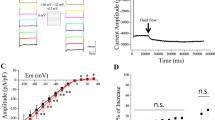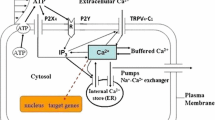Abstract
In this paper, a dynamic model is proposed to quantify the relationship between fluid flow and Cl−-selective membrane current in vascular endothelial cells (VECs). It is assumed that the external shear stress would first induce channel deformation in VECs. This deformation could activate the Cl− channels on the membrane, thus allowing Cl− transport across the membrane. A modified Hodgkin–Huxley model is embedded into our dynamic system to describe the electrophysiological properties of the membrane, such as the Cl−-selective membrane current (I), voltage (V) and conductance. Three flow patterns, i. e., steady flow, oscillatory flow, and pulsatile flow, are applied in our simulation studies. When the extracellular Cl− concentration is constant, the I-V characteristics predicted by our dynamic model shows strong consistency with the experimental observations. It is also interesting to note that the Cl− currents under different flow patterns show some differences, indicating that VECs distinguish among and respond differently to different types of flows. When the extracellular Cl− concentration keeps constant or varies slowly with time (i.e. oscillates at 0.02 Hz), the convection and diffusion of Cl− in extracellular space can be ignored and the Cl− current is well captured by the modified Hodgkin–Huxley model alone. However, when the extracellular Cl− varies fast (i.e., oscillates at 0.2 Hz), the convection and diffusion effect should be considered because the Cl− current dynamics is different from the case where the convection-diffusion effect is simply ignored. The proposed dynamic model along with the simulation results could not only provide more insights into the flow-regulated electrophysiological behavior of the cell membrane but also help to reveal new findings in the electrophysiological experimental investigations of VECs in response to dynamic flow and biochemical stimuli.
Similar content being viewed by others
References
Ando J, Komatsuda T, Kamiya A (1988) Cytoplasmic calcium response to fluid shear stress in cultured vascular endothelial cells. In Vitro Cell Dev Biol Anim 24: 871–877
Barakat AI, Leaver EV, Pappone PA, Davies PF (1999) A flow-activated chloride-selective membrane current in vascular endothelial cells. Circ Res 85: 820–828
Barakat AI (2001) A model for shear stress-induced deformation of a flow sensor on the surface of vascular endothelial cells. J Theor Biol 210: 221–236
Barakat AI, Barakat DK, Gojova A (2006) Secrets of the code: do vascular endothelial cells use ion channels to decipher complex flow signals?. Biomaterials 27: 671–678
Davies PF (1995) Flow-mediated endothelial mechanotransduction. Physiol Rev 75: 519–560
Fung YC (1981) Biomechanics: mechanical properties of living tissues. Springer, New York
Gautam M, Gojova A, Barakat AI (2006a) Flow-activated ion channels in vascular endothelium. Cell Biochem Biophys 46: 277–284
Gautam M, Shen Y, Thirkill TL, Douglas GC, Barakat AI (2006b) Flow-activated chloride channels in vascular endothelium - shear stress sensitivity, desensitization dynamics, and physiological implications. J Biol Chem 281: 36492–36500
Hoger JH, Ilyin VI, Forsyth S, Hoger A (2002) Shear stress regulates the endothelial Kir2.1 ion channel. PNAS 99: 7780–7785
Hodgkin A, Huxley A (1952) A quantitative description of membrane current and its application to conduction and excitation in nerve. J Physiol 117: 500–544
Hu XQ, Xiang C, Cao LL, Xu Z, Qin KR (2008) A mathematical model for ATP-mediated calcium dynamics in vascular endothelial cells induced by fluid shear stress. Appl Math Mech-Engl 29(10): 1291–1298
John K, Barakat AI (2001) Modulation of ATP/ADP concentration at the endothelial surface by shear stress: effect of flow-induced ATP release. Ann Biomed Eng 29: 740–751
Johnson TD (2003) Bayesian deconvolution analysis of pulsatile hormone concentration profile. Biometrics 59: 650–660
Keener J, Sneyd J (1998) Mathematical physiology. Springer, New York
Lide DR (2003–2004) Handbook of chemistry and physics, 8th edn. CRC Press, Boca Raton
Lieu DK, Pappone PA, Barakat AI (2004) Differential membrane potential and ion current responses to different types of shear stress in vascular endothelial cells. Am J Physiol Cell Physiol 286: C1367–C1375
Mazzag BM, Tamaresis JS, Barakat AI (2003) A model for shear stress sensing and transmission in vascular endothelial cells. Biophys J 84: 4087–4101
Nilius B, Droogmans G (2001) Ion channels and their functional role in vascular endothelium. Physiol Rev 81: 1415–1459
Park SW, Byun D, Bae YM, Choi BH, Park SH, Kim B, Cho SI (2007) Effects of fluid flow on voltage-dependent calcium channels in rat vascular myocytes: Fluid flow as a shear stress and a source of artifacts during patch-clamp studies. Biochem Biophys Res Comm 358: 1021–1027
Pontrelli G, Tatone A (2007) Concentration wave of a solute in an artery: the influence of curvature. Comput methods biomech biomed eng 10(2): 129–136
Qin KR, Xiang C, Xu Z, Cao LL, Ge SS, Jiang ZL (2008) Dynamic modeling for shear stress induced ATP release from vascular endothelial cells. Biomechan Model Mechanobiol 7: 345–353
Qin KR, Xiang C, Ge SS (2010) Generation of dynamic biochemical signals with a tube mixer: effect of dispersion in an oscillatory flow. Heat Mass Transf 46: 675–686
Schuster A, Beny JL, Meister JJ (2003) Modelling the electrophysiological endothelial cell response to bradykinin. Eur Biophys J 32: 370–380
Silva HS, Kapela A, Tsoukias NM (2007) A mathematical model of plasma membrane electrophysiology and calcium dynamics in vascular endothelial cells. Am J Physiol Cell Physiol 293: C277–C293
Stoer J, Bulirsch R (1993) Introduction to numerical analysis, 2nd edn. Springer, New York
Wang S, Meng F, Mohan S, Champaneri B, Gu YC (2009) Functional ENaC channels expressed in endothelial cells: a new candidate for mediating shear force. Microcirculation 16: 276–287
Wiesner TF, Berk BC, Nerem RM (1997) A mathematical model of the cytosolic-free calcium response in endothelial cells to fluid shear stress. PNAS 94: 3726–3731
Wong AYK, Klassen GA (1995) A model for electrical activity and cytosolic calcium dynamics in vascular endothelial cells in response to fluid shear stress. Ann Biomed Eng 23: 822–832
Xiang C, Cao LL, Qin KR, Lee TH (2010) Dynamic modeling and control of extracellular ATP concentration on vascular endothelial cells via shear stress modulation. J Control Theory Appl 8: 326–332
Author information
Authors and Affiliations
Corresponding author
Rights and permissions
About this article
Cite this article
Qin, KR., Xiang, C. & Cao, LL. Dynamic modeling for flow-activated chloride-selective membrane current in vascular endothelial cells. Biomech Model Mechanobiol 10, 743–754 (2011). https://doi.org/10.1007/s10237-010-0270-2
Received:
Accepted:
Published:
Issue Date:
DOI: https://doi.org/10.1007/s10237-010-0270-2




